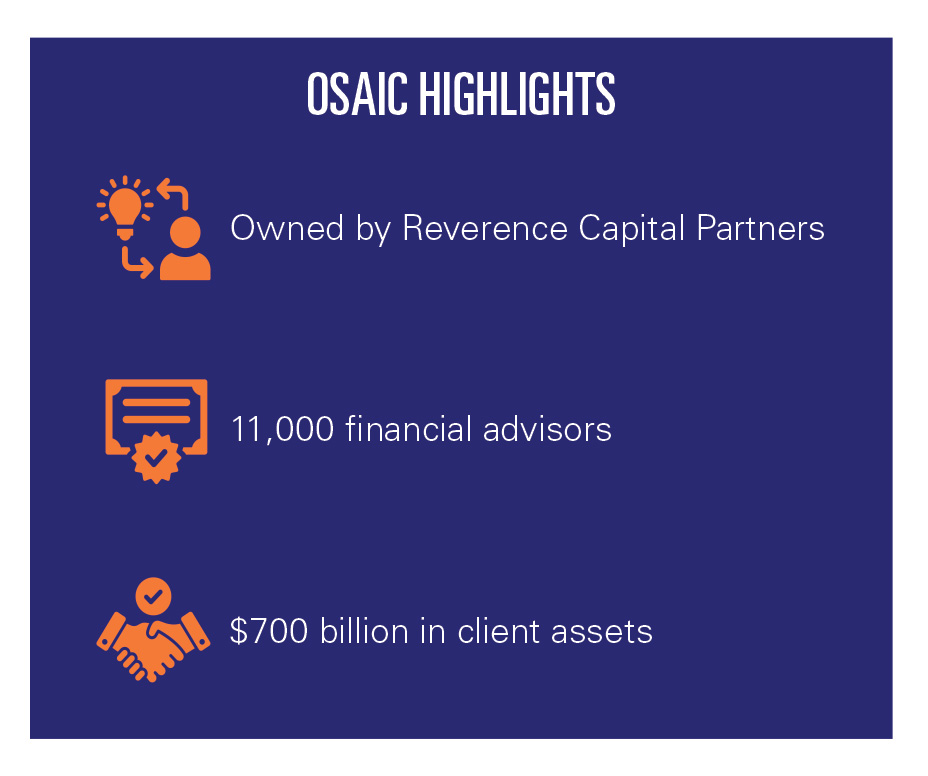

Earning big-time pay – and then fighting over it – go together like steak and eggs on Wall Street.
Financial advisors frequently skirmish with their broker-dealers or registered investment advisors about compensation. Just think about recent lawsuits former Morgan Stanley brokers have brought against their old firm that center on who – the firm or the advisor – controls valuable deferred compensation-plan cash.
What’s unusual in fights over money is for a senior executive, in this case a former veteran CEO, to take the dispute public. Wall Street prefers to keep such contretemps private and behind closed doors.
But not former Securities America Inc. chief executive Jim Nagengast. In April, he sued Osaic Inc., the brand name for the brokerage firm network that bought Securities America in 2020 when he was in charge.
Nagengast claims that Osaic and Artemis Holdings are in breach of contract due to the private sale of partnership units of the business to the company’s management and employees last September.
After that sale, Osaic allegedly has not paid him the full amount he is owed, and he is seeking an unknown amount of damages, according to the complaint, which was filed in April in federal court in Delaware.
The lawsuit was originally filed under seal and was later released but in a highly redacted form, which means many of the specific details of Nagengast’s complaint remain private. For example, it’s not clear how many partnership units Nagengast controls, or their potential value.
Nagengast resigned from Securities America in January 2024, and later that year the firm shut down after moving its advisors and assets to Osaic Wealth Inc. as part of the broker-dealer network’s efforts to have one brand and reduce overhead. Jamie Price is the president and CEO of Osaic.
“This is unorthodox,” said Louis Tambaro, an industry attorney. “From a litigator’s perspective, it would seem to me that something deeper is going on – the executive may anticipate claims from the employer and is trying to get out in front with this claim to change the narrative.”
“I’ve known Jim for 30 years, and he’s never struck me a litigious person,” said one senior industry executive, who spoke privately to InvestmentNews about the matter. “He’s a real gentleman with a diplomat’s personality.”
“As company policy, Osaic does not comment on ongoing litigation,” a company spokesperson said.
Nagengast could not be reached to comment, and his attorney, Matthew Boyer, also declined to comment.
Nagengast in 1994 began working at Securities America, which was based in Omaha, NE, and had 1,700 financial advisors under its roof when he was in charge.
He stayed for 30 years and became president and then CEO. Several executives noted that Nagengast almost single-handedly kept the firm alive after the credit crisis of 2008.
First, a giant money market fund, the Reserve Primary Fund, in September 2008 infamously “broke the buck,” or saw its net asset value fall below a dollar, wiping out $60 million in client money overnight. The firm’s owner at the time, Ameriprise Financial Inc., then said it was paying its own clients who lost money in the fund but not those at Securities America, setting off an internal firestorm at the firm.
That was followed by a years-long saga of litigation and questions about the firm’s future after it came to light that the firm’s financial advisors sold $400 million in high-risk private placements from 2003 to 2009 that later went into default. After senior management at Ameriprise considered shutting Securities America down, Ameriprise eventually sold the firm in 2011 to Ladenburg Thalmann for $150 million.
It’s rare for any CEO to steer a firm through one, let alone two, such crises.
Senior executives are reluctant to sue their old firms because they could get the reputation of a troublemaker, a label the financial advice industry abhors. That could lead to never being in the running for the top job at a large firm again.
Of course, public disputes about compensation between large financial institutions like broker-dealers and senior management occur from time to time.
LPL Financial Holdings Inc. and its former CEO Dan Arnold, who was fired last fall, said in December they had reached a settlement regarding Arnold’s stock options, which had been deferred when the board fired him for cause on October 1.
Under the settlement, Arnold walked away with options worth $12 million, or about 15 percent of the aggregate total value of the severance benefits and equity awards that he would have been entitled to receive or retain had he been terminated “without cause” or “for good reason,” LPL Financial Holdings said Monday morning in a filing with the Securities and Exchange Commission.
Back-of-the-envelope math shows that Arnold’s total benefits and stock awards before being fired were close to $80 million.
Executives were quick to note that Arnold was fired for cause and Nagengast had resigned in good standing, a clearly different pattern of facts.
Regarding Nagengast’s lawsuit alleging breach of contract, Tambaro added: “A party to an agreement such as this is always going to expect fair compensation and especially proper disclosure in the event of a minority sale of shares.”

By listening for what truly matters and where clients want to make a difference, advisors can avoid politics and help build more personal strategies.

JPMorgan and RBC have also welcomed ex-UBS advisors in Texas, while Steward Partners and SpirePoint make new additions in the Sun Belt.

Counsel representing Lisa Cook argued the president's pattern of publicly blasting the Fed calls the foundation for her firing into question.

The two firms violated the Advisers Act and Reg BI by making misleading statements and failing to disclose conflicts to retail and retirement plan investors, according to the regulator.

Elsewhere, two breakaway teams from Morgan Stanley and Merrill unite to form a $2 billion RIA, while a Texas-based independent merges with a Bay Area advisory practice.
Orion's Tom Wilson on delivering coordinated, high-touch service in a world where returns alone no longer set you apart.
Barely a decade old, registered index-linked annuities have quickly surged in popularity, thanks to their unique blend of protection and growth potential—an appealing option for investors looking to chart a steadier course through today's choppy market waters, says Myles Lambert, Brighthouse Financial.
